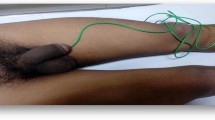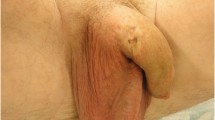Abstract
Background
Intravesical foreign bodies leading to bladder stone and renal insufficiency are rarely reported in literature.
Case presentation
We report a case of 18-year-old male who presented with renal insufficiency due to bladder outlet obstruction caused by bladder stone formed over electric wire that was self-inserted 1 year ago. We present the symptoms, imaging, diagnosis and treatment of unique complications due to self-insertion of intravesical foreign body. We performed the open vesicolithotomy uneventfully and patient sent for psychiatric evaluation. Our patient’s case was unique for several reasons i.e., inserted foreign body was electric wire, symptoms duration was not very long and it resulted in life threatening complication of renal failure.
Conclusion
There should be high index of suspicion in young patients with bladder foreign bodies presenting with lower urinary tract symptoms.
Similar content being viewed by others
1 Background
Foreign bodies are relatively rare in urology but most commonly found in bladder due to varying etiologies i.e., iatrogenic, self-insertion, sexual assault, migration from adjacent structures and penetrating trauma [1]. A wide range of foreign bodies have been reported in the literature like needles, pens, wooden sticks, thermometer, copper wire, parts of Foley’s catheters, knotted suprapubic catheters and broken parts of endoscopic instruments [2, 3]. Most patients avoid treatment out of shame and embarrassment and present late with complications i.e., lower urinary tract symptoms, bladder stone, fistulas and even renal failure [4, 5]. We are reporting a case of bladder foreign body presenting as bladder stone and causing renal failure.
2 Case presentation
An 18-year male presented in outpatient clinic with 15 days history of hesitancy, poor urinary stream, hematuria, shortness of breath, peri-orbital puffiness and decrease urinary output. Examination revealed mild pedal edema and fine crepitations in chest. Laboratory investigations showed Hemoglobin of 10.1 g/dL, TLC count of 14,000, serum creatinine of 23 g/dL and potassium of 7.1 mmol/L. All other baseline investigations were normal. Ultrasonography of abdomen demonstrates bilateral moderate hydroureteronephrosis and large bladder stone. Patient was admitted and on consultation with nephrologist immediate hemodialysis started via right internal jugular catheter. After stabilization of patient, Non contrast CT abdomen was performed which showed bilateral hydroureteronephrosis with relatively small left kidney and large bladder stone (Fig. 1). Our diagnosis was of obstructive uropathy due to large bladder stone. He underwent vesicolithotomy after informed consent and pre-operative optimization. Intraoperatively, the stone was soft and surprisingly we found a large electric wire intertwined with stone which was removed with stone (Fig. 2). On further enquiry after surgery, he admitted self-insertion of electric wire 1 year ago for sexual gratification which acted as a nidus for bladder stone and led to renal failure. Patient was followed with serial creatinine monitoring and sent for psychological counselling after discharge. Psychologist gave opinion that he is not suffering from sexual addiction or autoeroticism and this single event of self-insertion of electric wire was out of curiosity.
3 Discussion
Foreign bodies in upper urinary tract are relatively rare and mainly caused by iatrogenic injuries while the etiologies of foreign bodies in lower urinary tract are multiple i.e., self-insertion for sexual gratification, iatrogenic, accidental, trauma and migration from adjacent structures [6, 7]. In literature, various iatrogenic objects reported in bladder i.e., catheter tips, parts of catheter balloons, forgotten DJ stent with encrustations, buggies, beaks of resectoscope sheaths while Self-Inflicted foreign bodies reported are crystal glass stirrers, copper wire, metallic cables, lead pencil and ball pen [8]. Psychological aspects like mental illness, exotic impulse and personality disorders should be considered in patients with self-insertion of foreign bodies [9].
Most patients have LUTS and present early while few have mild or no symptoms and present late with complications like bladder stone, oliguria, renal failure or bladder fistulas. Symptoms caused by intravesical foreign bodies are frequency, urgency, dysuria, suprapubic pain, hematuria, strangury, poor urinary stream and urinary retention [10, 11]. Our patient present late with complication of renal failure.
Diagnosis of intravesical foreign body is relatively easy and simple plain radiograph of abdomen can confirm radiopaque foreign body and bladder stone. Ultrasound KUB is sufficient for radiolucent stones and to demonstrate proximal hydronephrosis while CT KUB needed in some cases to measure the exact size of bladder stone formed on foreign body and to plan surgery like in our case. Cystoscopy is the definitive diagnostic procedure for diagnosis of intravesical foreign body.
The aim of treatment should be to remove the foreign body and to avoid the complications. The method of removal of foreign body should be selected on the basis of shape, size, nature and mobility of foreign body. Endoscopic treatment should be attempted first as minimal trauma to patient [12]. In literature some cases of removal of foreign bodies by percutaneous or laparoscopic approach are reported to minimize the risk of open surgery [13, 14]. Open surgery is indicated for large or sharp foreign bodies and in cases of failed endoscopic attempt. In our case, open vesicolithotomy was done as bladder stone was very large.
Iatrogenic foreign bodies are mostly soft now a days and usually present early while self- inserted are hard or dangerous and mostly present late with complications due to embarrassment. Psychiatric evaluation of these patients needed as some of these patients may be suffering from autoeroticism or sexual addiction and objects inserted for these purposes may be dangerous which can lead to life threatening complications [15].
4 Conclusion
Intravesical foreign bodies are relatively common and can lead to life threatening complications. High index of suspicion should be made in young patients presenting with lower urinary tract symptoms. Psychiatric evaluation should be done in patients with self-inflicted bladder foreign body.
Availability of data and materials
All data generated or analyzed during this study is available in this published article.
Abbreviations
- LUTS:
-
Lower urinary tract symptoms
- KUB:
-
Kidney ureter and bladder
References
Odoemene CA, Onuh CA (2017) Foreign bodies in the urinary bladder-case series. J West Afr Coll Surg 7(3):124
Tahaoglu M, Ozturk S, Ozturk H (2014) Self-insertion of needle as urethral foreign body after sexual gratification: an unusual case report. Pediatr Urol Case Rep 1(5):10–14
Rafique M (2008) Intravesical foreign bodies: review and current management strategies. Urol J 5(4):223–231
Sharma SP, Chowdhary S, Upadhyay AD, Yadav MK, Sharma SP (2020) A foreign body in the urinary bladder leads to bladder stone and vesicorectal fistula: a case report. Pediatr Urol Case Rep 7(2):45–51
Kamal F, Clark AT, Lavallée LT, Roberts M, Watterson J (2008) Intravesical foreign body–induced bladder calculi resulting in obstructive renal failure. Can Urol Assoc J 2(5):546
Van Ophoven A, De Kernion JB (2000) Clinical management of foreign bodies of the genitourinary tract. J Urol 164(2):274–287
Eckford SD, Persad RA, Brewster SF, Gingell JC (1992) Intravesical foreign bodies: five-year review. Br J Urol 69(1):41–45
Bansal A, Yadav P, Kumar M, Sankhwar S, Purkait B, Jhanwar A, Singh S (2016) Foreign bodies in the urinary bladder and their management: a single-centre experience from North India. Int Neurourol J 20(3):260
Moon SJ, Kim DH, Chung JH, Jo JK, Son YW, Choi HY, Moon HS (2010) Unusual foreign bodies in the urinary bladder and urethra due to autoerotism. Int Neurourol J. 14(3):186
Deka PM, Rajeev TP (2001) Unusual cause of hematuria. Urol Int 66(1):41–42
Mustafa M (2009) Erosion of an intrauterine contraceptive device through the bladder wall causing calculus: management and review of the literature. Urol Int 82(3):370–371
Alkan E, Basar MM (2014) Endourological treatment of foreign bodies in the urinary system. J Soc Laparoendosc Surg: JSLS 18(3):e2014.00271
Hutton KR, Huddart SN (1999) Percutaneous retrieval of an intravesical foreign body using direct transurethral visualization: a technique applicable to small children. Br J Urol. 83(3):337–8
Van Ophoven A, de Kernion JB (2000) Clinical management of foreign bodies of the genitourinary tract. J Urol. 164(2):274–87
Rieder J, Brusky J, Tran V, Stern K, Aboseif S (2010) Review of intentionally self-inflicted, accidental and iatrogetic foreign objects in the genitourinary tract. Urol Int 84(4):471–475
Acknowledgements
None.
Funding
None.
Author information
Authors and Affiliations
Contributions
SJ were involved in managing the patient, formalizing and writing the manuscript. MA were involved in management of patient and proof reading of manuscript. MM were involved in management of patient and pre-operative dialysis of patient. All authors read and approved the final manuscript.
Corresponding author
Ethics declarations
Ethics approval and consent to participate
ERC exemption taken and Consent to participate taken from patient.
Consent for publication
Consent for publication taken from patient.
Competing interests
The authors declare that they have no competing interests.
Additional information
Publisher's Note
Springer Nature remains neutral with regard to jurisdictional claims in published maps and institutional affiliations.
Rights and permissions
This article is published under an open access license. Please check the 'Copyright Information' section either on this page or in the PDF for details of this license and what re-use is permitted. If your intended use exceeds what is permitted by the license or if you are unable to locate the licence and re-use information, please contact the Rights and Permissions team.
About this article
Cite this article
Jamil, S., Adnan, M. & Muzammil, M. Self-induced intravesical foreign body leading to bladder stone and renal failure: a case report. Afr J Urol 28, 36 (2022). https://doi.org/10.1186/s12301-022-00300-y
Received:
Accepted:
Published:
DOI: https://doi.org/10.1186/s12301-022-00300-y






